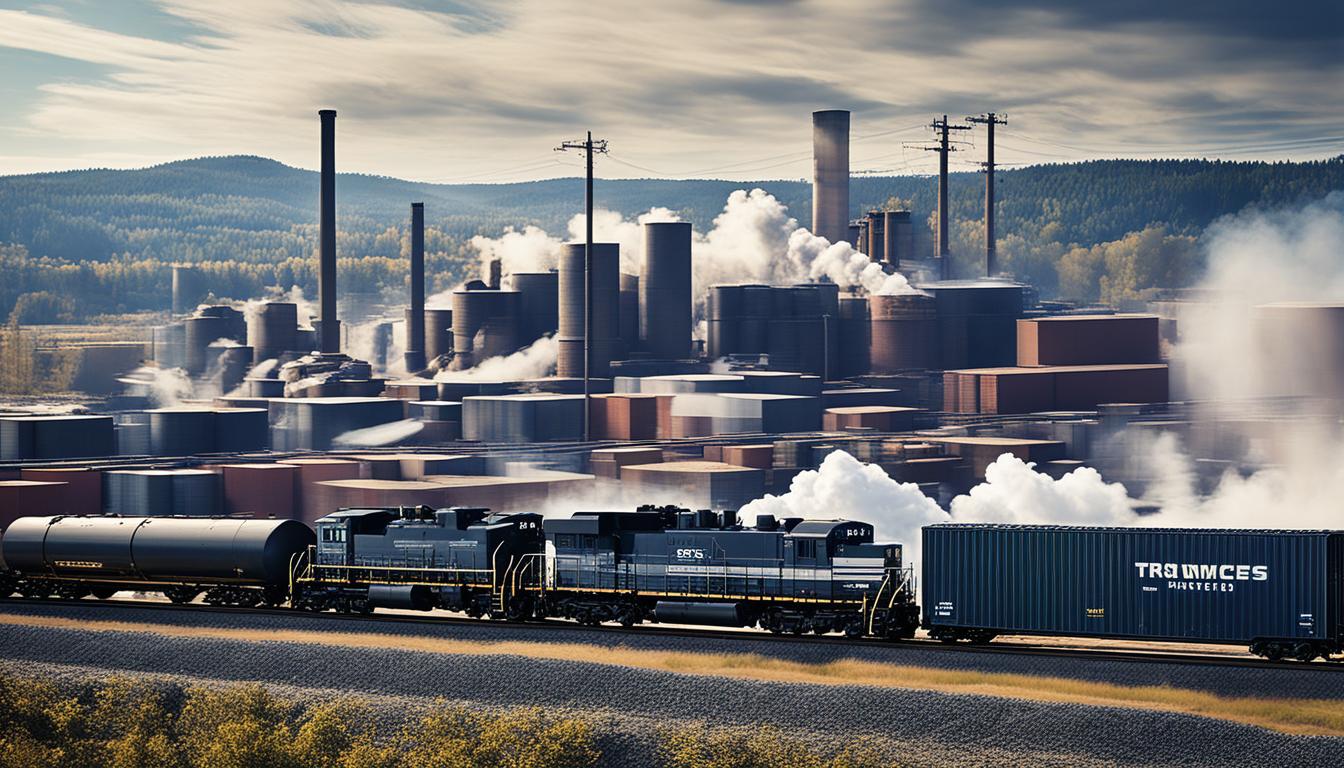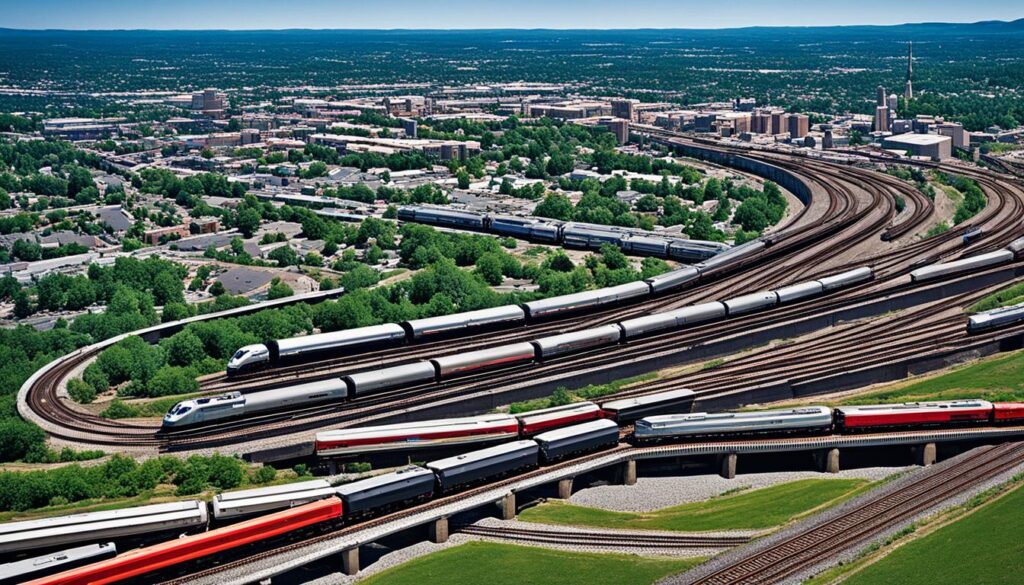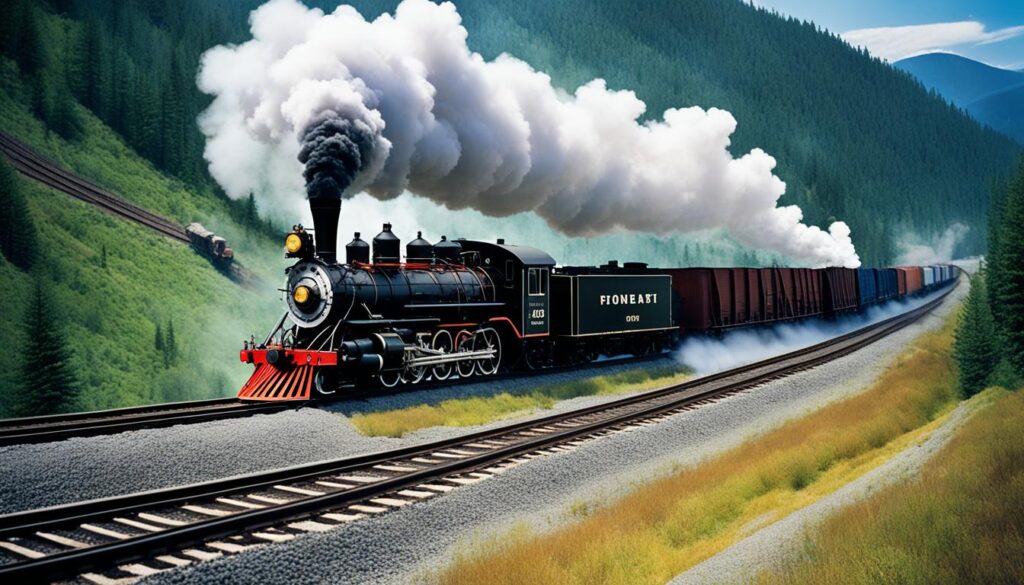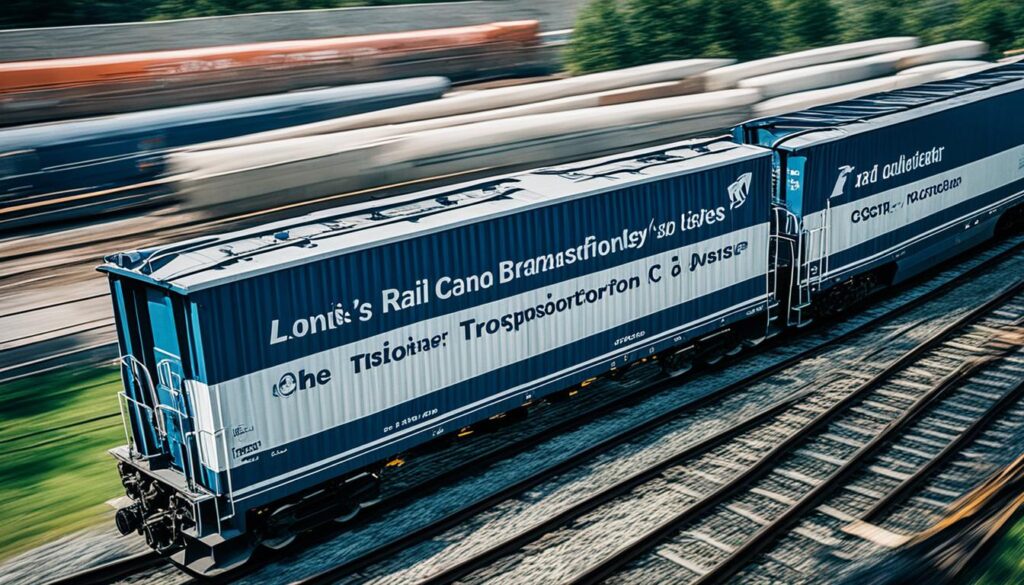
The advent of railroad technology in the 19th century had a profound impact on industries and agriculture in America. The speed and efficiency of rail transportation revolutionized the way goods were shipped, leading to increased profits for companies. Businesses benefited from faster and cheaper shipping methods, allowing them to produce more and reach more markets, ultimately resulting in higher earnings.
The importance of railroads in 19th century America cannot be overstated. The completion of the Transcontinental Railroad was a significant event that brought about major advancements in transportation and connectivity. The railroad provided faster and more efficient means of shipping goods, allowing businesses to expand their reach and access new markets, which greatly contributed to overall profitability.
Key Takeaways:
- Railroad technology improved company profits through faster and cheaper shipping methods
- The railroad was one of the most important inventions of the 19th century, revolutionizing transportation and connectivity
- Early challenges faced by railroads included the lack of standardized track gauges and competition from other transportation modes
- Advancements in railroad technology, such as the invention of the steam engine, improved transportation capacity and efficiency
- The expansion of rail networks and increased transportation capacity contributed to company profits and stimulated industry growth
The Importance of the Railroads in 19th Century America
The railroad was one of the most important inventions of the 19th century, revolutionizing transportation and connectivity. Its impact on the economy was profound, offering numerous advantages to businesses and driving profitability. With the completion of the Transcontinental Railroad in 1869, railway developments reached new heights, transforming the landscape of America’s industries and agriculture.
The economic advantages of railroad technology were immense. Rail transportation provided faster and more efficient means of shipping goods, enabling businesses to meet market demands more effectively. Companies could transport larger volumes of products over greater distances, opening up new markets and expanding their customer base. Rapid and reliable rail connections facilitated the growth of industries by ensuring the timely delivery of raw materials and finished goods.
Railways also played a crucial role in connecting remote regions, reducing transportation costs, and boosting trade. The accessibility and affordability of rail transportation made it easier for businesses to access resources, locate manufacturing facilities, and distribute their products. This increased connectivity stimulated economic growth and created new opportunities for companies to thrive.
The development and expansion of rail networks were instrumental in improving the overall profitability of businesses. Railways not only offered quicker transportation, but they also provided energy-efficient and cost-effective solutions. Companies could save on fuel costs by utilizing locomotives powered by steam engines, which were highly efficient compared to other transportation modes at the time.
Railway developments resulted in a notable shift in the business landscape, with companies strategizing around the benefits and opportunities presented by the railroads. They could leverage the reach and efficiency of railways to streamline their supply chains, reduce inventory costs, and improve overall operational efficiency.
The growth of railroads created new opportunities for businesses, allowing them to tap into previously inaccessible markets and achieve higher levels of efficiency in their operations. This resulted in increased profitability and a significant impact on the overall economic landscape.
Moreover, the economic advantages of railroads extended beyond just transportation. Railways brought about advancements in urban development, as cities grew and flourished around the presence of rail lines. The access to reliable transportation attracted investment and fostered economic prosperity in regions with rail connections.
The Economic Advantages of Railroad Technology
To further understand the economic benefits brought about by railroad technology, let’s take a look at some key advantages:
| Advantages | Description |
|---|---|
| Lower Transportation Costs | Rail transportation offered cost savings through economies of scale and reduced fuel consumption compared to other transportation modes. |
| Increased Efficiency | Railways provided faster and more reliable transportation, reducing delivery times and improving supply chain efficiency for businesses. |
| Expanded Markets | Through rail connections, businesses gained access to new markets, enabling them to target a wider customer base and increase sales. |
| Improved Connectivity | Railways connected previously isolated regions, opening up opportunities for trade and economic growth. |
| Industrial Growth | Railroads stimulated the growth of industries such as mining, agriculture, and manufacturing, leading to job creation and increased production. |
The economic advantages of railroad technology were instrumental in shaping the business landscape of 19th century America. The railways propelled industries forward, transformed economies, and paved the way for further advancements in transportation and technology. The impact of the railroads on company profits was undeniable, making it a game-changer in the realm of business profitability.
Early Challenges Faced by Railroad Technology
In the early days of railroad technology, several challenges hindered its progress and impact on transportation and businesses. These challenges included the lack of standardized track gauges, primitive steam engine technology, and competition from other transportation modes.
“The lack of standardized track gauges posed a significant challenge for early railroads. Different regions and companies had varying track widths, making it difficult for trains to seamlessly travel across different networks. This lack of standardization resulted in inefficiencies and delays, hampering the growth of the railroad industry.”
The primitive steam engine technology used in early railroads was also a major obstacle. These early steam engines were prone to breakdowns and had limited power, often causing delays and reducing the reliability of rail transportation. Advances in steam engine technology were necessary to improve efficiency and profitability.
Furthermore, railroads faced tough competition from other transportation modes, such as canals and turnpikes. These alternative modes offered their own advantages and were well-established in certain regions. The competition made it challenging for railroads to gain a competitive edge and attract significant traffic and investment.
The Lack of Standardized Track Gauges
“The lack of standardized track gauges was a significant hurdle for railroads in the early years. Trains traveling between regions with different track widths required time-consuming and costly readjustments, resulting in suboptimal efficiency.”
Primitive Steam Engine Technology
“Early steam engines used in railroads were far from perfect. They often suffered from breakdowns, requiring frequent maintenance and causing delays in transportation. The limited power of these engines also restricted their ability to carry heavy loads over long distances.”
Competition from Other Modes of Transportation
“Railroads faced fierce competition from canals and turnpikes, which had established transportation networks and were preferred by some industries and regions. This competition posed challenges for railroads, requiring them to prove their superiority and attract businesses to utilize their services.”
Overcoming these challenges required innovation and advancements in railroad technology. Standardizing track gauges, improving steam engine technology, and marketing the unique advantages of rail transportation were crucial steps in transforming railroads into the dominant mode of transportation in the following years.

| Challenges | Description |
|---|---|
| Lack of standardized track gauges | Varying track widths between regions and companies made seamless travel difficult and resulted in inefficiencies and delays. |
| Primitive steam engine technology | Frequent breakdowns and limited power of early steam engines reduced reliability and transportation capacity. |
| Competition from other transportation modes | Canals and turnpikes offered alternative modes of transportation, making it challenging for railroads to attract traffic and investment. |
Advancements in Railroad Technology
The invention of the steam engine revolutionized rail transportation, providing a reliable and powerful source of locomotion. Steam locomotives could haul heavier loads over longer distances, increasing transportation capacity and allowing companies to move larger quantities of products. The steam engine also improved the speed and efficiency of railroads, making them more attractive to businesses. The impact of the steam engine on railroads was profound, transforming the industry and paving the way for further advancements.
Introduction of Electric Locomotives and Diesel Engines
Building upon the success of steam-powered trains, the introduction of electric locomotives and diesel engines marked another significant milestone in railroad technology. Electric locomotives, powered by overhead electrical wires or third-rail systems, provided a cleaner and more efficient mode of transportation. They offered improved acceleration, smoother operation, and reduced maintenance costs compared to steam locomotives. Diesel engines, on the other hand, brought the advantage of greater fuel efficiency and flexibility, allowing trains to operate in areas without electrified tracks.
The development and implementation of these new propulsion technologies expanded the possibilities of railway transportation, opening up new opportunities for businesses. Electric locomotives and diesel engines offered enhanced performance, reliability, and environmental sustainability, further propelling the growth and profitability of the railroad industry.
To illustrate the advancements in railroad technology, the table below compares the key features of steam locomotives, electric locomotives, and diesel engines:
| Feature | Steam Locomotives | Electric Locomotives | Diesel Engines |
|---|---|---|---|
| Power Source | Steam generated by burning coal or wood | Electricity from overhead wires or third-rail systems | Diesel fuel combustion |
| Fuel Efficiency | Low | High | High |
| Acceleration | Slower | Higher | Higher |
| Emissions | Smoke, ash, and steam | None (Zero direct emissions) | Lower (than steam locomotives) |
| Maintenance | High | Low | Low |

Expansion of Rail Networks and Increased Transportation Capacity
As rail technology continued to advance, the expansion of rail networks became a pivotal factor in transforming transportation and benefiting various industries. Rail networks expanded rapidly, connecting previously isolated regions and creating a vast network of transportation routes.
The expansion of rail networks brought about a significant increase in transportation capacity. Railroads were able to transport larger volumes of goods more quickly and efficiently than ever before. This enhanced transportation capacity had a profound impact on businesses, allowing them to move goods and raw materials across long distances with ease.
One of the key benefits of rail transportation was the improvements it offered to the overall supply chain efficiency. With the expansion of rail networks, businesses could transport goods directly from production centers to markets, eliminating the need for intermediate handling and reducing overall transportation costs. This streamlined approach resulted in faster turnaround times and increased profitability for companies.
The expansion of rail networks had a direct impact on a wide range of industries. For example, the mining industry benefited greatly from the ability to transport large quantities of minerals and resources to factories and markets. Rail transportation also played a crucial role in the growth of the agriculture industry, allowing farmers to transport their products efficiently and quickly to urban centers.
The benefits of rail transportation extended beyond individual industries. The availability of efficient and cost-effective transportation enabled businesses to expand their markets and reach customers in previously inaccessible regions. This increased accessibility opened up new opportunities for trade, contributing to the overall economic growth of the country.

| Industry | Impact of Rail Transportation |
|---|---|
| Mining | Efficient transportation of minerals and resources leading to increased production and profitability. |
| Agriculture | Fast and reliable transportation of agricultural products to urban centers, expanding market reach and boosting profitability. |
| Manufacturing | Access to raw materials and efficient distribution of finished products, improving supply chain efficiency and reducing costs. |
| Retail | Ability to source products from a wider range of suppliers and reach customers in distant locations, increasing market presence and sales. |
The expansion of rail networks and the resulting increase in transportation capacity revolutionized the movement of goods and people across the country. It laid the foundation for economic growth and prosperity, providing businesses with the means to thrive and expand their operations. As rail technology continued to evolve, it further enhanced the efficiency and capabilities of rail transportation, solidifying its position as a vital component of industry and commerce.
Technological Advancements in Railroad Industry
Continuous efforts were made in the railroad industry to develop faster and more efficient technologies. Innovations in locomotive designs, such as larger boilers and improved valve systems, increased speed and performance. The invention of the air brake system and automatic couplers improved safety and efficiency in train operations. The use of steel rails replaced iron rails, resulting in stronger and more durable tracks. These advancements in railroad technology reduced maintenance costs and improved the overall profitability of the industry.

Innovations in locomotive designs played a crucial role in advancing railroad technology. By incorporating larger boilers and improved valve systems, locomotives were able to generate more power and increase their speed. This allowed trains to transport goods more quickly and efficiently, contributing to the overall profitability of the industry.
The introduction of the air brake system and automatic couplers revolutionized train operations. Prior to this innovation, braking systems were manually operated, resulting in longer stopping distances and increased risks. The air brake system allowed for quicker and more reliable braking, improving the safety and efficiency of train operations. Automatic couplers made it easier and faster to connect and disconnect cars, streamlining the process of assembling and disassembling trains.
Another significant advancement was the use of steel rails. Steel rails replaced the less durable iron rails, offering increased strength and longevity. Steel rails could withstand heavier loads and frequent train traffic, resulting in reduced maintenance costs and improved overall profitability for the railroad industry.
“The introduction of larger boilers, improved valve systems, air brake systems, automatic couplers, and steel rails marked significant advancements in the railroad industry. These technological innovations enhanced the speed, efficiency, and safety of train operations, ultimately boosting profitability for companies involved in rail transportation.” – Railroad Technology Magazine
Advancements in Railroad Technology Table
| Technological Advancements | Description |
|---|---|
| Larger Boilers and Improved Valve Systems | Innovative locomotive designs that increased power and speed. |
| Air Brake System | Invention that improved safety and efficiency in train operations. |
| Automatic Couplers | Innovative mechanism that simplified the process of connecting and disconnecting cars. |
| Steel Rails | Replacement of iron rails with stronger and more durable steel rails. |
Cost Savings and Efficiency Benefits of Rail Transportation
Rail transportation offers significant cost savings for businesses. The efficiency and capacity of railroads allow companies to transport large volumes of goods in a single trip, resulting in a reduction in transportation costs. By achieving economies of scale, businesses can decrease per-unit transportation costs, leading to higher profit margins.
In addition to cost savings, rail transportation is known for its efficiency. With the ability to carry large loads, railroads can efficiently move goods over long distances, providing a reliable and timely delivery system for businesses. This reduces the risk of late deliveries and the associated costs, ensuring that companies can meet customer demands and maintain a competitive edge in the market.
Furthermore, rail transportation offers environmental advantages. Compared to other modes of transportation, such as road or air, trains are more fuel-efficient, resulting in lower carbon emissions. This aligns with businesses’ commitment to sustainability and helps them comply with environmental regulations.
Overall, the advantages of rail transportation for businesses include cost savings, efficiency, and environmental friendliness. By leveraging rail networks, companies can optimize their supply chains, streamline operations, and enhance their profitability.
Advantages of Rail Transportation for Businesses:
- Significant cost savings through the transportation of large volumes of goods in a single trip.
- Efficiency in moving goods over long distances, ensuring reliable and timely deliveries.
- Fuel efficiency and reduced carbon emissions, supporting environmental sustainability.

| Advantages | Description |
|---|---|
| Cost Savings | Rail transportation enables economies of scale, reducing per-unit transportation costs for businesses. |
| Efficiency | Railroads can transport large volumes of goods efficiently, resulting in reliable and timely deliveries. |
| Environmental Friendliness | Trains are more fuel-efficient and produce fewer carbon emissions compared to other transportation modes. |
Did the Adoption of Modern Technology Impact Railroad Companies’ Profits?
The impact of modern technology on railroad companies’ profits has been significant. The adoption of advanced systems for track maintenance, train scheduling, and fuel efficiency has streamlined operations and reduced costs. Additionally, new customer-facing technologies have improved the overall passenger experience, leading to increased revenue for these companies.
Conclusion
The impact of railroad technology on company profits cannot be understated. The speed, efficiency, and capacity of rail transportation revolutionized the way goods were shipped, resulting in increased profitability for businesses. The advancements in railroad technology, such as the invention of the steam engine, expansion of rail networks, and development of faster and more efficient technologies, contributed to the growth and success of companies in the 19th century and beyond.
Companies benefited from the cost savings, reduced transportation times, and improved connectivity offered by railroads. The ability to transport large volumes of goods in a single trip allowed businesses to achieve economies of scale and reduce per-unit transportation costs. Railroads provided a reliable and efficient mode of transportation, ensuring timely deliveries and reducing the risk of late deliveries and associated costs for companies.
The importance of railroads in the 19th century America cannot be overstated. The expansion of rail networks connected previously isolated regions, stimulating the growth of industries such as mining and agriculture. Rail transportation became a crucial factor in driving company profits, offering significant advantages such as reduced transportation costs, increased transportation capacity, and improved supply chain efficiency. Overall, the advancements in railroad technology played a pivotal role in shaping the economic landscape of America and contributing to the profitability of businesses.








